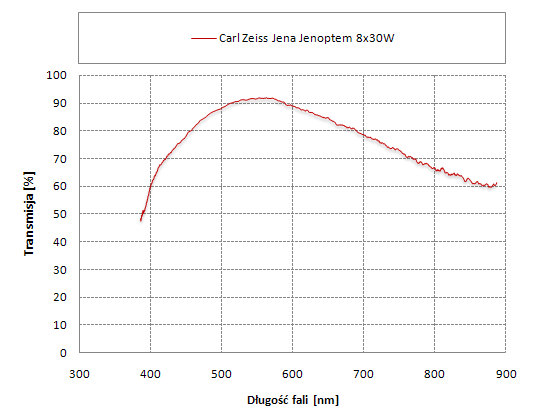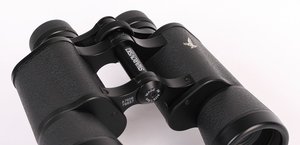Carl Zeiss Jena Jenoptem 8x30W
Both the Deltrintem and the Jenoptem are classic devices with achromatic objectives and Porro prisms. At first those binoculars were equipped with a 4-element eyepiece without any anti-reflection coatings. During the WWII the producers started to cover their air-to-glass surfaces with a single anti-reflection layer of magnesium fluoride. In 1947 the binoculars got a new Erfle 5-lens eyepiece which was supposed to give a wide field of view with a minimum distortion level. In 1978 they started to use new multilayer coatings with a characteristic orange-purple hue.
Around 1990 when the Jena plant was taken over by the Docter company, the binoculars not only didn’t go out of production but even were given improved multi-coatings. Its production, already under the Docter brand name, ceased only ca.1995.
The specimen, tested by us, had the serial number of 6173583, which means it was produced in 1985. The binoculars feature the newer multi-coatings then. In the set with the binoculars you get a thin strap and a small soft case.
Distribution / Sales:

| Magnification | Lens diameter | Angular field of view | Prisms | Eye relief | Weight | Price |
|---|---|---|---|---|---|---|
| 8 | 30 | 150/1000(8.5o) | BaK-4/Porro | ? mm | 520 g | 400 PLN |
Summary
Pros:
- classic and solid casing,
- very wide field of view,
- high transmission in the centre of the visible spectrum,
- slight astigmatism,
- chromatic aberration controlled quite well,
- very wide IPD range,
- good quality BaK-4 prisms.
Cons:
- significant blur on the edge of the field of view,
- distinctly yellow image,
- noticeable distortion,
- a lot of reflections coming from the area near prisms,
- short eye relief,
- slightly truncated pupils.
In our test of 8x32 class binoculars we couldn’t omit the classic Zeiss instruments from Jena. They were produced in such a huge number that you can still buy a pair of these in good condition second-hand and the price, ranging from about 50 to 150 Euro, is quite affordable. We were motivated by curiosity how a set of binoculars, produced over 20 or 30 years ago, compare with those currently manufactured; we also deeply believed that they were still able to outperform contemporary instruments made in China. Time for a reality check.
Not so long ago we published the test of its twin brother, the Deltrintem 8x30. Its results are in many categories practically the same as the Jenoptem, tested now. The overall result, reached by these both instruments differs in 0.4 of a point, which is a negligible value taking into account measurement errors and the fact, that these binoculars have had several owners so far. Because their performances, looks and parameters are so similar perhaps nobody will be surprised that a significant part of the summary is also the same as in the test of the Deltrintem.
Two Zeiss 8×30 binoculars from Jena – on the left Jenoptem, right Deltrintem. |
Let’s start with evident advantages. The tested set of binoculars is 25-year-old. Despite that it is in close to perfect condition – even better than the Deltrintem tested some time ago. Its optics is in equally good shape than the casing. The lenses are clean and flawless, without any mould inside. There are some specks of dust on the prisms but it is quite understandable taking into account the age of the device. Its condition places the workmanship quality in a very favourable light – after next twenty five years the Jenoptem 8x30, tested here, will look still the same, providing it is used in a similar way of course. I doubt whether any contemporary product made in China and bought for a sum not exceeding 250 Euro is able to survive equally well even a much shorter period of time.
The next advantage is the field of view. Once a huge field of view counted a lot and the Jenoptem boasts such a feature. It is almost by half a degree wider than the widest field of view found in contemporary competitors, even those very reputable.
The set of binoculars corrects astigmatism and chromatic aberration quite well. You can’t complain about the coma level too much either. The parameters, given by the producer, are followed with perfect exactitude – the objective lens’s diameter and magnification are in accordance with the numbers in documentation.
The classic Porro prism construction, not many optical elements and multilayer coatings made the transmission in the middle of the visual spectrum rather high, amounting to 91-92%. This result is very good – in fact other cheaper roof-prism instruments can only dream of it.
 |
What’s interesting, this result is about 1-2% lower than that of the Deltrintem. Should we worry about it? Rather not. Instruments which have been stored and used in different conditions for 25 years can differ slightly when it comes to the oxidizing of the coatings. A difference between particular specimen can be also a factor here – the binoculars from Jena were really mass-produced goods after all. Of course measurement errors could also add to that but their influence is most probably the smallest.
The right colour rendition can be a problem, though, for Jenoptem and Deltrintem and other binoculars from Jena as well. In the 80s of 20th century the coatings were already multi-layered but still optimized only for the centre of visual spectrum. As a result the transmission for yellow light is high but for blue and red it becomes even by 20% worse. That’s why the image is distinctly yellow. The effect was perhaps smaller than in the case of one-layer coatings, used before 1978, but still it is too visible for contemporary standards.
As we’ve already passed to disadvantages, we must also mention the other negative points. The edge of the field of view, which is not sharp enough, and noticeable distortion can be certainly counted among them. What’s more, the usage of such wide-angle eyepieces made the exit pupils distinctly truncated.
Nowadays, most of binoculars, even those cheaper ones (but I don’t include here market-bought specimens costing less than 50 Euro) are waterproof and nitrogen-filled. In the case of the Jenoptem 8x30 we can’t count on that.
To sum up despite the passage of time the Jenoptem 8x30 seems to be still a very interesting option. Although you can get a bargain, usually you must pay for this device about 70-100 Euro, sometimes even 130 Euro. For such an amount of money you would be hard-pressed to find a really good 8x30 or 8x32 alternative, though, so the Jena product can still be attractive
Carl Zeiss Jena Jenoptem 8×30W and Steiner Night Hunter 8×30 XP – German Porro binoculars 25 years ago and now. |
The risk, involved in purchasing anything second hand is an issue, though. It happens very often that a set of binoculars touted by its seller as being “in perfect condition” can be hardly described as such. This bad practice is notoriously common.
Anyway if you decide to buy something on the second hand market you must give it your full attention – otherwise you might end up sending your bargain purchase to an optics specialists and paying extra money for repair or cleaning. I do recommend buying only from sources you can rely on and the direct contact is always the best.
















